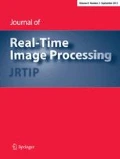Abstract
Functional magnetic resonance imaging allows non-invasive measurements of brain dynamics and has already been used for neurofeedback experiments, which relies on real time data processing. The limited computational resources that are typically available for this have hindered the use of connectivity analysis in this context. A basic, but already computationally demanding analysis method of neural connectivity is correlation analysis that computes all pairwise correlations coefficients between the measured time series. The parallel nature of the problem predestines it for an implementation on massive parallel architectures as realized by GPUs and FPGAs. We show what performance benefits can be achieved when compared with current desktop CPUs. The use of correlation analysis is not limited to brain research, but is also relevant in other fields of image processing, e.g. for the analysis of video streams.


Similar content being viewed by others
References
Gipp, M.: Correlation analysis of functional magnetic resonance imaging data using fpga hardware. In: Gipp, M., Gembris, D., Lienhart, G., Kugel, A., Männer, R. Proceedings of the ISMRM, p. 2855 (2006)
deCharms, R.C.: Applications of real-time fMRI. Nat. Rev. Neurosci. 9(9), 720–729 (2008) (review)
Biswal, B., Yetkin, F.Z., Haughton, V.M., Hyde, J.S.: Functional connectivity in the motor cortex of resting human brain using echo-planar MRI. Magn. Reson. Med. 34(4), 537–541 (1995)
Eguluz, V.M., Chialvo, D.R., Cecchi, G.A., Baliki, M., Apkarian, A.V.: Scale-free brain functional networks. Phys. Rev. Lett. 94(1), 018102 (2005)
Press, W.H., Teukolsky, S.A., Vetterling, W.T., Flannery, B.P.: Numerical recipes, 2nd edition: the art of scientific computing. Cambridge University Press, Cambridge (1992)
Description of Analyze format, available at: http://www.mayo.edu/bir/PDF/ANALYZE75.pdf
Cates, J.E., Lefohn, A.E., Whitaker, R.T.: GIST: an interactive, GPU-based level set segmentation tool for 3D medical images. Med. Image Anal. 8(3), 217–231 (2004)
Jeong, W.K., Fletcher, P.T., Tao, R., Whitaker, R.: Interactive visualization of volumetric white matter connectivity in DT-MRI using a parallel-hardware Hamilton–Jacobi solver. IEEE Trans. Vis. Comput. Graph. 13(6), 1480–1481 (2007)
Hansen, M.S., Atkinson, D., Sorensen, T.S.: Cartesian SENSE and k-t SENSE reconstruction using commodity graphics hardware. Magn. Reson. Med. 59(3), 463–468 (2008)
Rehman T.U., Haber E., Pryor G., Melonakos J., Tannenbaum A.: 3D nonrigid registration via optimal mass transport on the GPU. In: Rehman T.U., Haber E., Pryor G., Melonakos J., Tannenbaum A. Magn. Reson. Med. 59(3), 463–468 (2008)
Lindholm, E., Nickolls, J., Oberman, S., Montrym, J.: NVIDIA Tesla: a unified graphics and computing architecture. IEEE Micro. 39–55 (2008)
Homepage of nvidia: http://www.nvidia.de/
Communications of the ACM, vol. 51, Issue 10 (October 2008)
GPU computing, ACM Queue, vol. 6, Issue 2 (March/April 2008)
NVIDIA Corporation, Compute Unified Device Architecture Programming Guide Version 1.0 (2007)
Gipp M.: Korrelationsanalyse von funktionalen Magnet-Resonanz-Daten mit FPGAs, master thesis, University of Mannheim, Mannheim, Germany (2006)
Online information on CUDA programming: http://www.nvidia.com/object/cuda_develop.html
FPGA Processors Group, Chair of Computer Science V in Mannheim. http://li5.ziti.uni-heidelberg.de/research/fpga-processors/processors/mprace/ (2008)
Pebbles, P.J.E.: The large-scale structure of the universe. Princeton University Press (1980)
Gembris, D., Taylor, J.G., Schor, S., Frings, W., Suter, D., Posse, S.: Functional magnetic resonance imaging in real time (FIRE): sliding-window correlation analysis and reference-vector optimization. Magn. Reson. Med. 43(2), 259–268 (2000)
Acknowledgments
We thank the Central Institute for Mental Health in Mannheim for providing the fMRI data set.
Author information
Authors and Affiliations
Corresponding author
Additional information
R. Männer is Head of the Chair of Computer Science V.
Rights and permissions
About this article
Cite this article
Gembris, D., Neeb, M., Gipp, M. et al. Correlation analysis on GPU systems using NVIDIA’s CUDA. J Real-Time Image Proc 6, 275–280 (2011). https://doi.org/10.1007/s11554-010-0162-9
Received:
Accepted:
Published:
Issue Date:
DOI: https://doi.org/10.1007/s11554-010-0162-9




